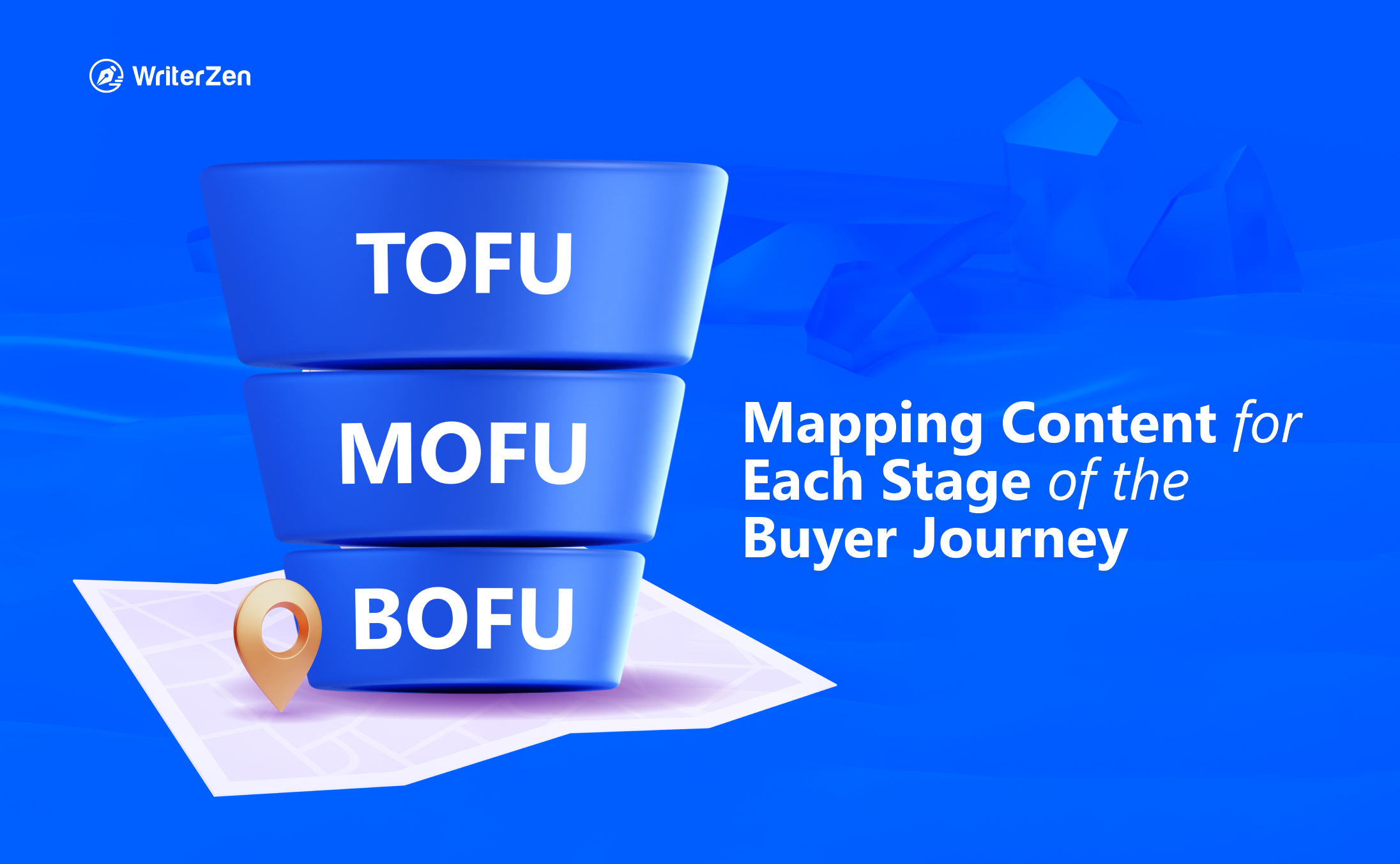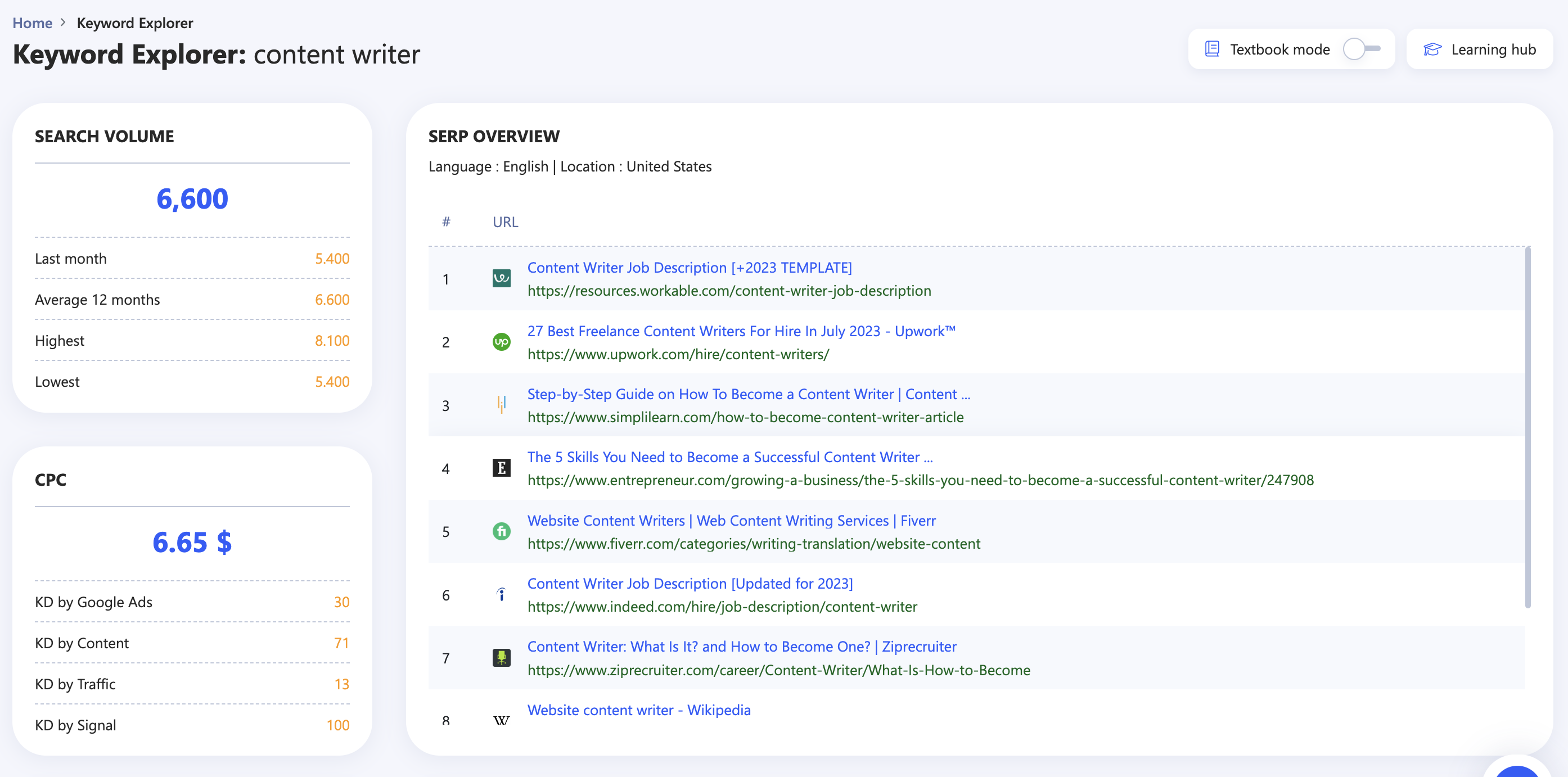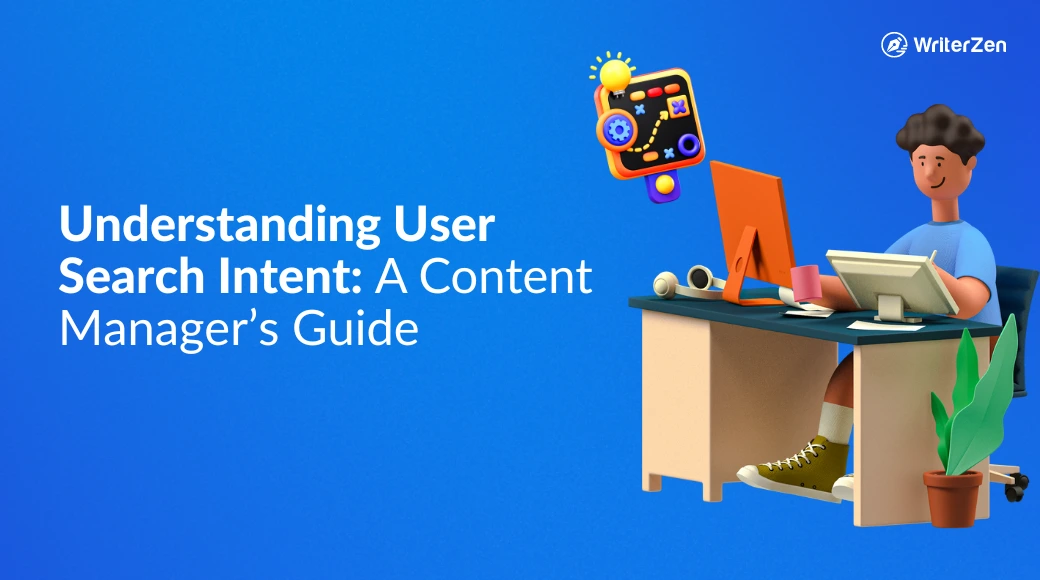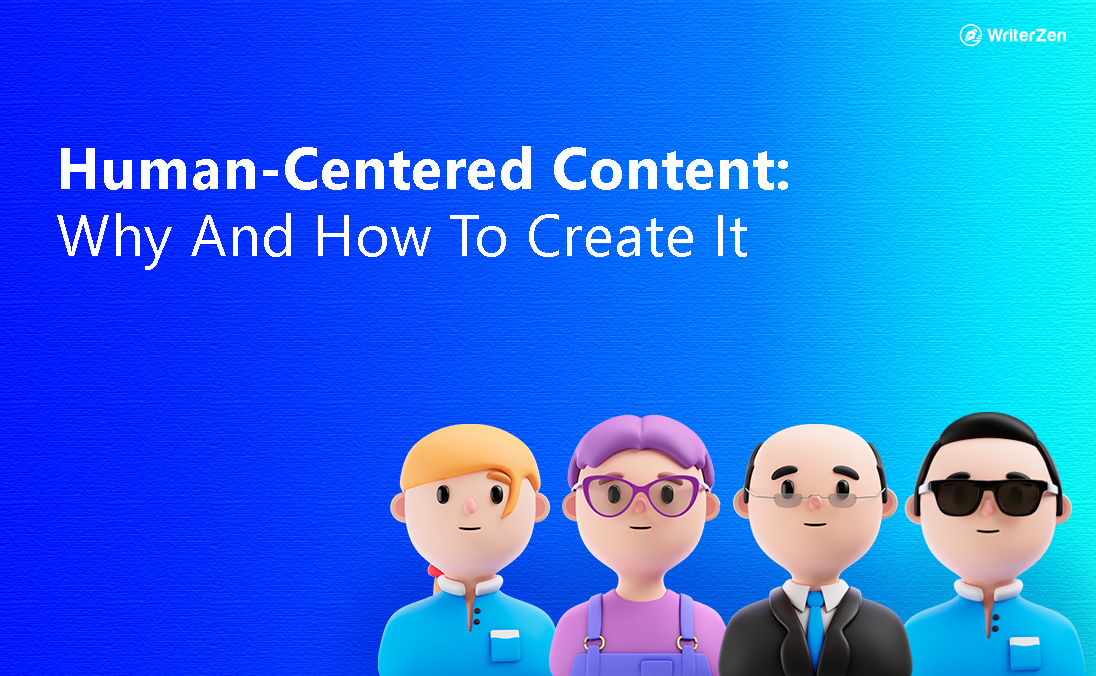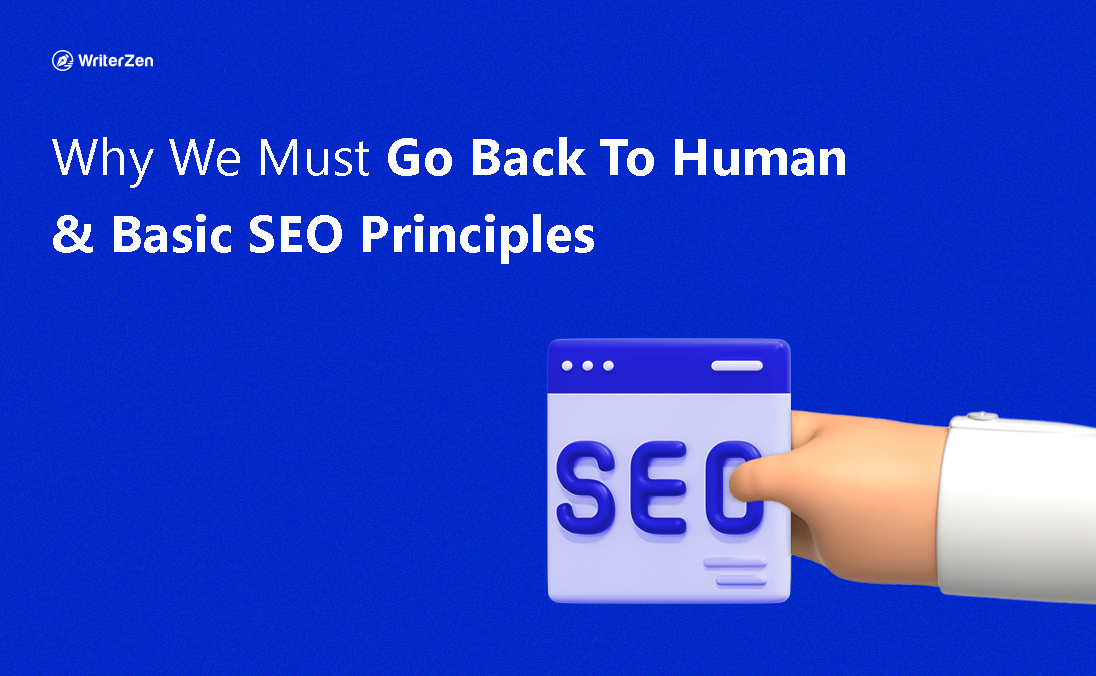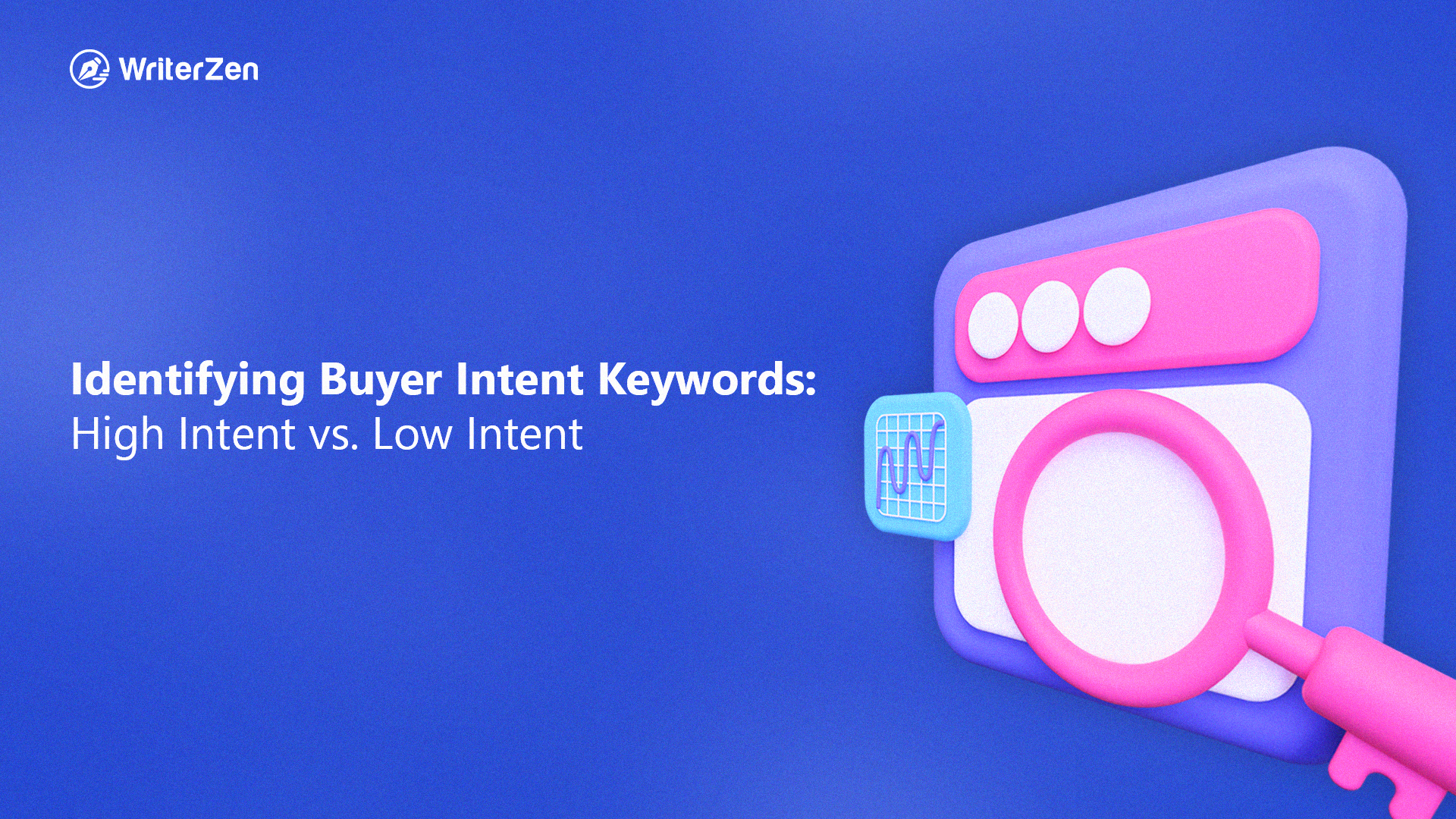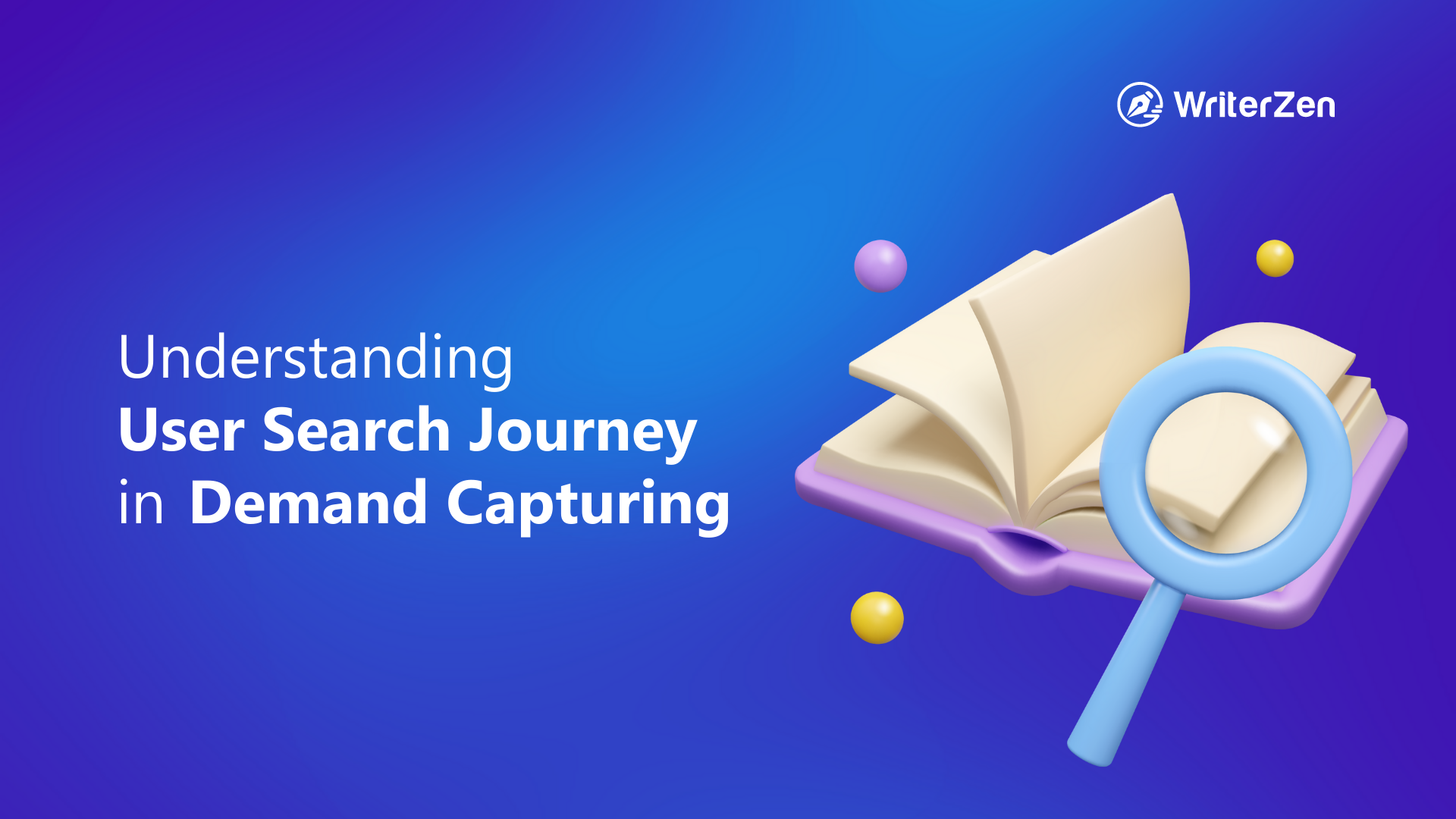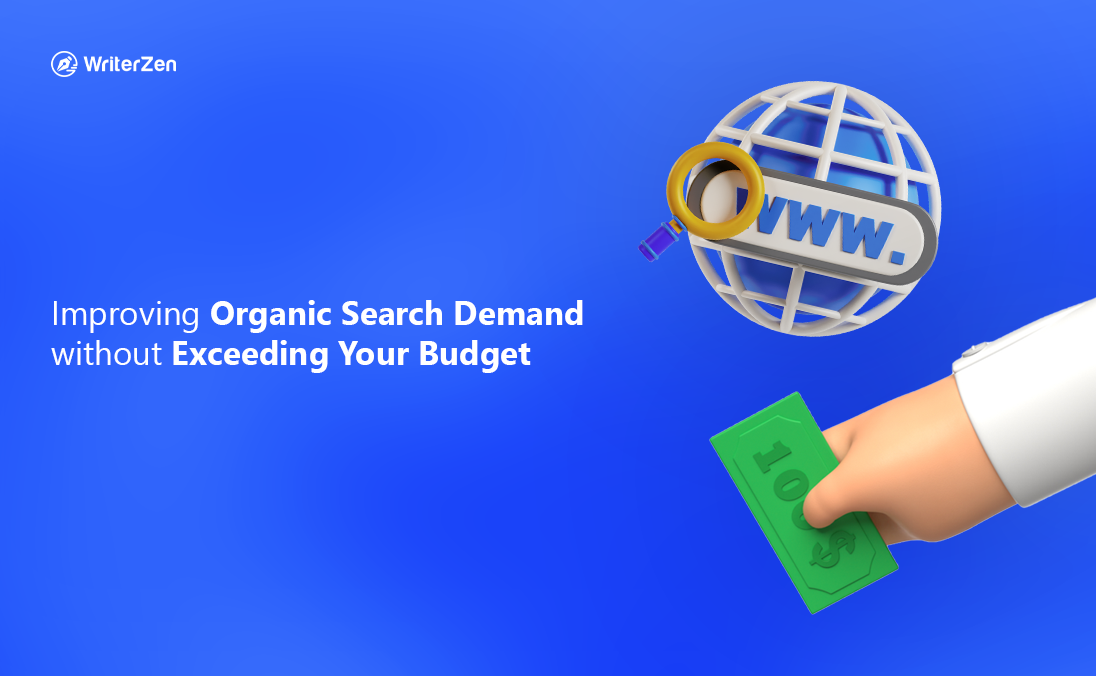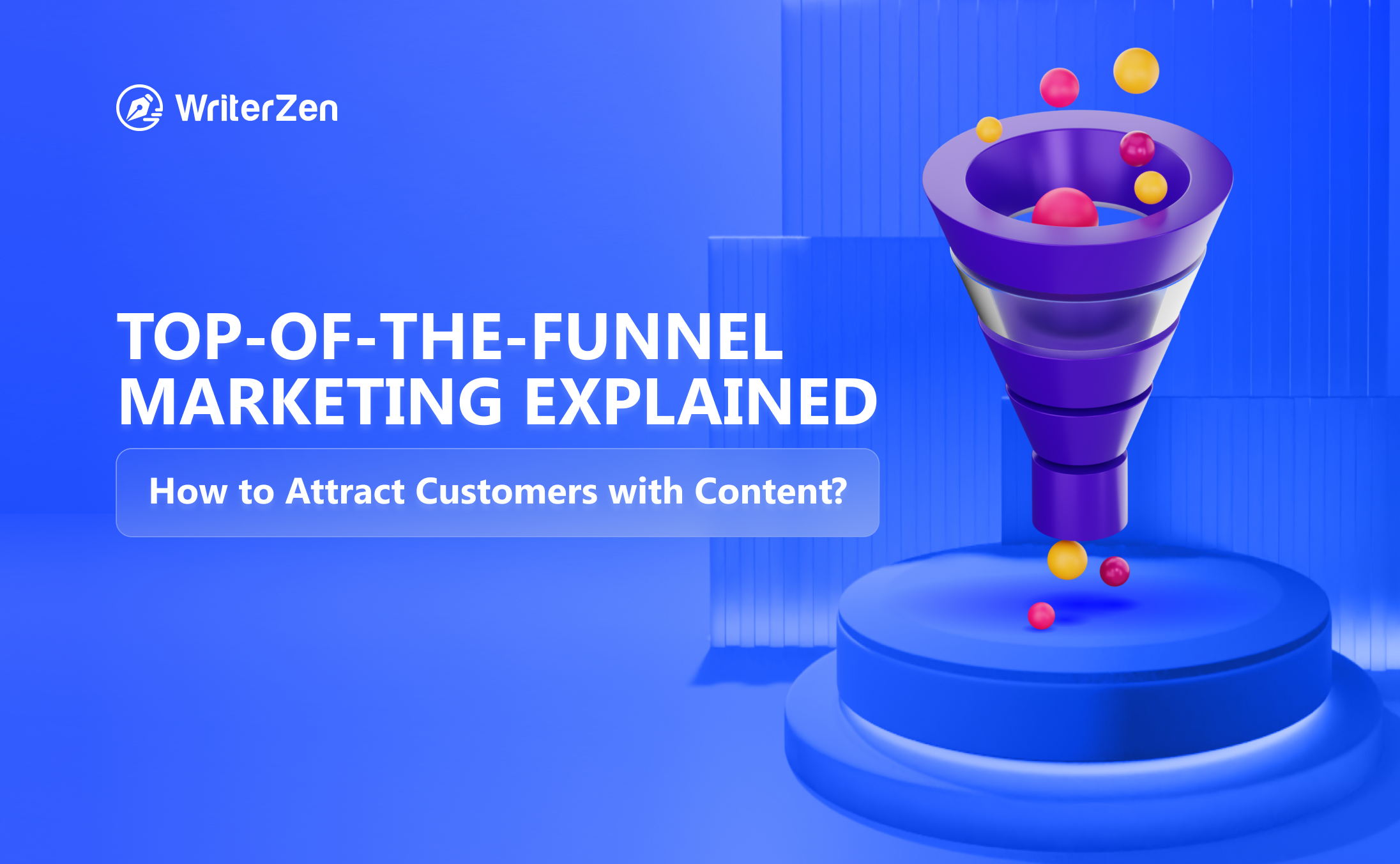The year was 1965.
Back in the time, acquiring customers was fairly simple.
With a little bit of advertising magic, you could entice customers with a tantalizing promotion, and before you know it, they'll be clamoring to try out the product. That’s it.
See how straightforward the buying journey was? But not any longer.
The modern-era buying journey is a lot more complicated and rarely linear. As buying behavior is on rapid evolution, understanding what triggers your ideal customers, how they explore, and evaluate before buying only gets trickier.
And depending on the price and other complexities, dozens of micro-decisions need to be made, objections cleared, and doubts mitigated before they say “YES” to your product.
In this article, we walk you through the stages of the buyer’s journey, shed light on the importance of mapping content for the entire funnel, and how you can persuade customers at each touch point with content.
Shedding Light on The Buyer’s Journey
From the moment a target customer discovers your product to finally becoming a paid customer, each touch point in the buying journey plays a substantial role in influencing their decision.
Therefore, mapping out the buyer’s journey can give you a clear overview of their behavior at each touchpoint.
Traditionally, the buyer’s journey is broken down into three stages: ToFu, MoFu, and BoFu, which stands for Top of the Funnel, Middle of the Funnel, and Bottom of the Funnel, respectively.
Marketers have molded the journey into a funnel that describes how each step leads to the next. At every stage of the sales cycle, customers face distinct challenges that can potentially hinder their decision to make a purchase.
You can knock down the challenges by mapping the journey and closely monitoring each touchpoint. Based on what you learn, you can refine their journey to ensure a smooth and seamless buying experience for your potential customers, which will ultimately increase the likelihood of conversion.
The following image precisely summarizes the relationship between the buyer’s journey and the marketing funnel.
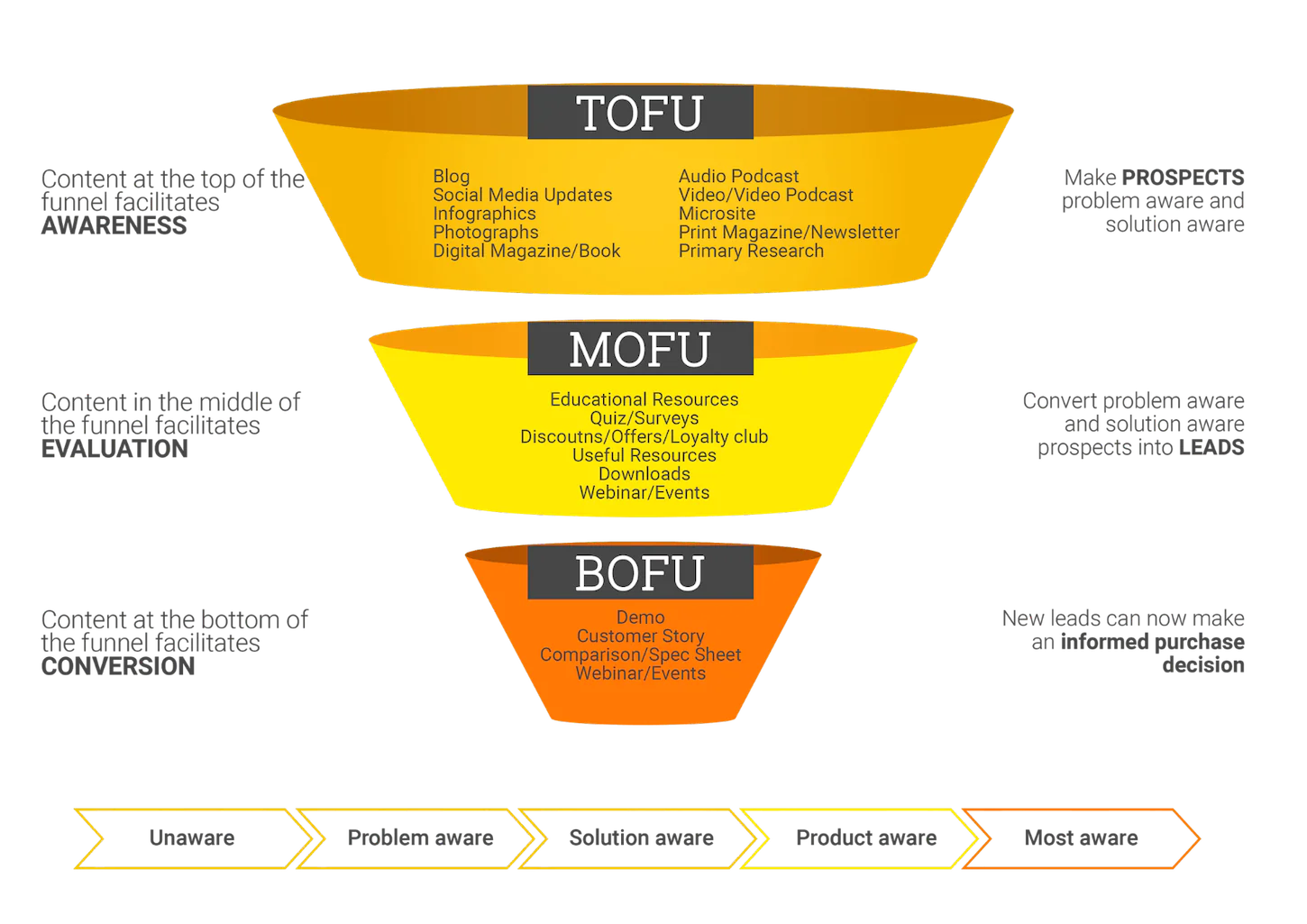
Source: Shopify
Stage 1: Awareness Stage (ToFu)
In the awareness stage, the prospective buyer knows they have a problem that needs a solution. Let’s say, Emma, who is in her 30s is experiencing back pain all of a sudden.
Unaware of what’s causing it, she turns to Google and searches, “Why do I have a bad back every morning?” Her goal, at this stage, is to educate herself and find the cause behind her pain.
After reading a few articles, particularly that of Casper’s, she realizes that a poor mattress might be the issue. This is known as the awareness stage of the buyer’s journey.
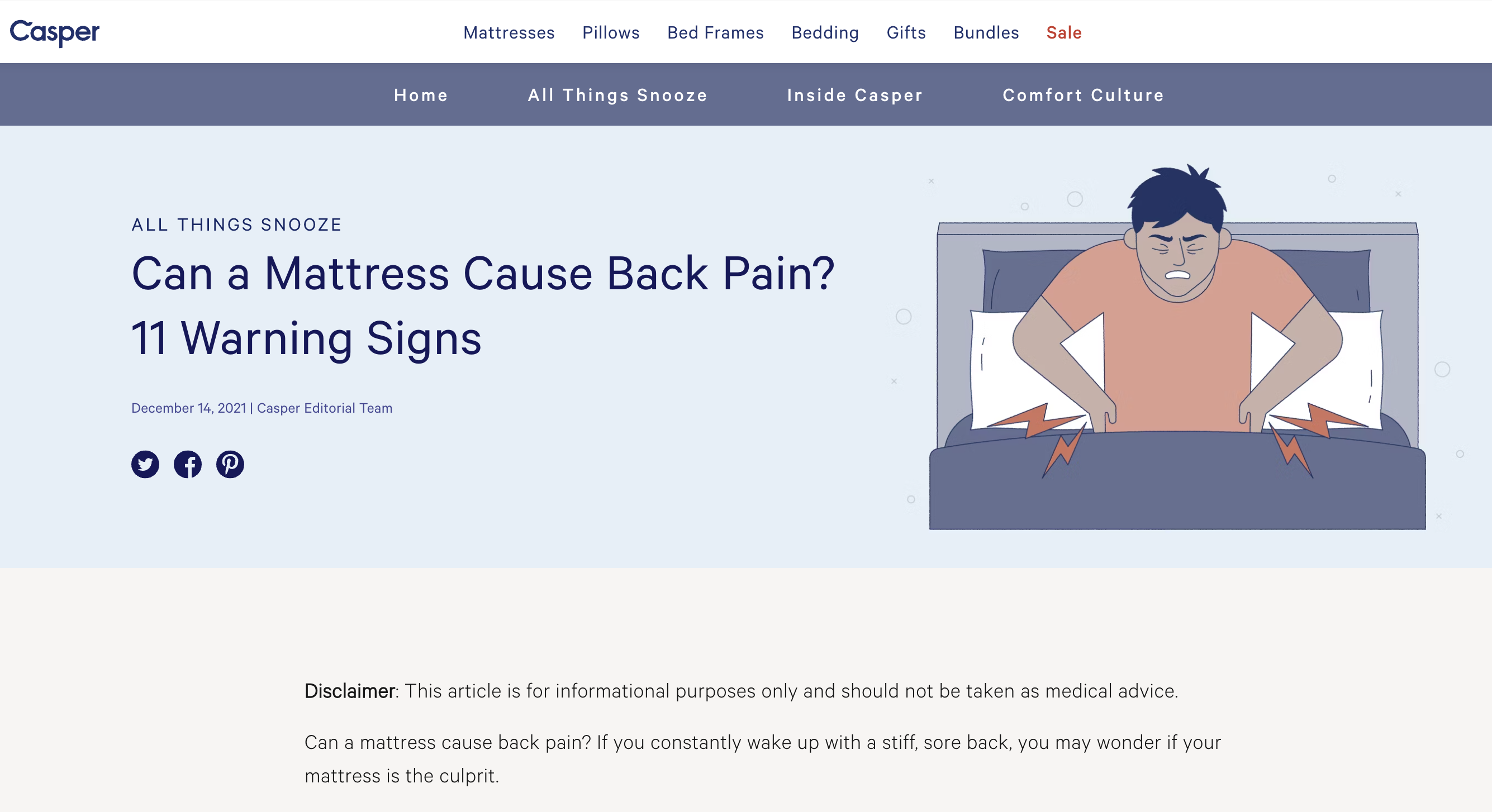
A mattress brand might not sound like the most obvious source of educational content, but Casper cleverly uses the subject of sleep to engage consumers who might be searching for its product.
In this way, you can provide potential customers with a solution by featuring relevant content. At this stage, prospects will come across either through organic search or paid ads.
Your goal at the awareness stage is to deeply understand the buyer’s challenges. Here’s how you go about it:
-
What’s the buyer’s biggest goal?
-
What’s the biggest obstacle in the way of that goal?
-
Where does your buyer go to troubleshoot their challenges?
-
How does the buyer decide to prioritize solving a challenge?
-
Who does the buyer ask for advice on their challenges and goals?
Customer need: “Why am I having back pain”
Your solution: Uncovers the core reasons for back pain with a practical solution to overcome it.
Stage 2: Consideration and Evaluation (MoFu)
Now that Emma is aware of her problem, she actively starts looking for a solution. She finds multiple brands selling mattresses and starts evaluating each of them.
This is basically the consideration stage. This is where you can generate leads by earning the confidence of your target demographic.
And to do so, elaborate on your product benefits so that it appears to be a good fit for the customer. Content like product-specific blog posts, customer testimonials, and vendor comparisons can come in handy to convince shoppers.
As you can see, Casper has a separate review page altogether to gain the trust of new shoppers - 92% of customers read online reviews before buying.
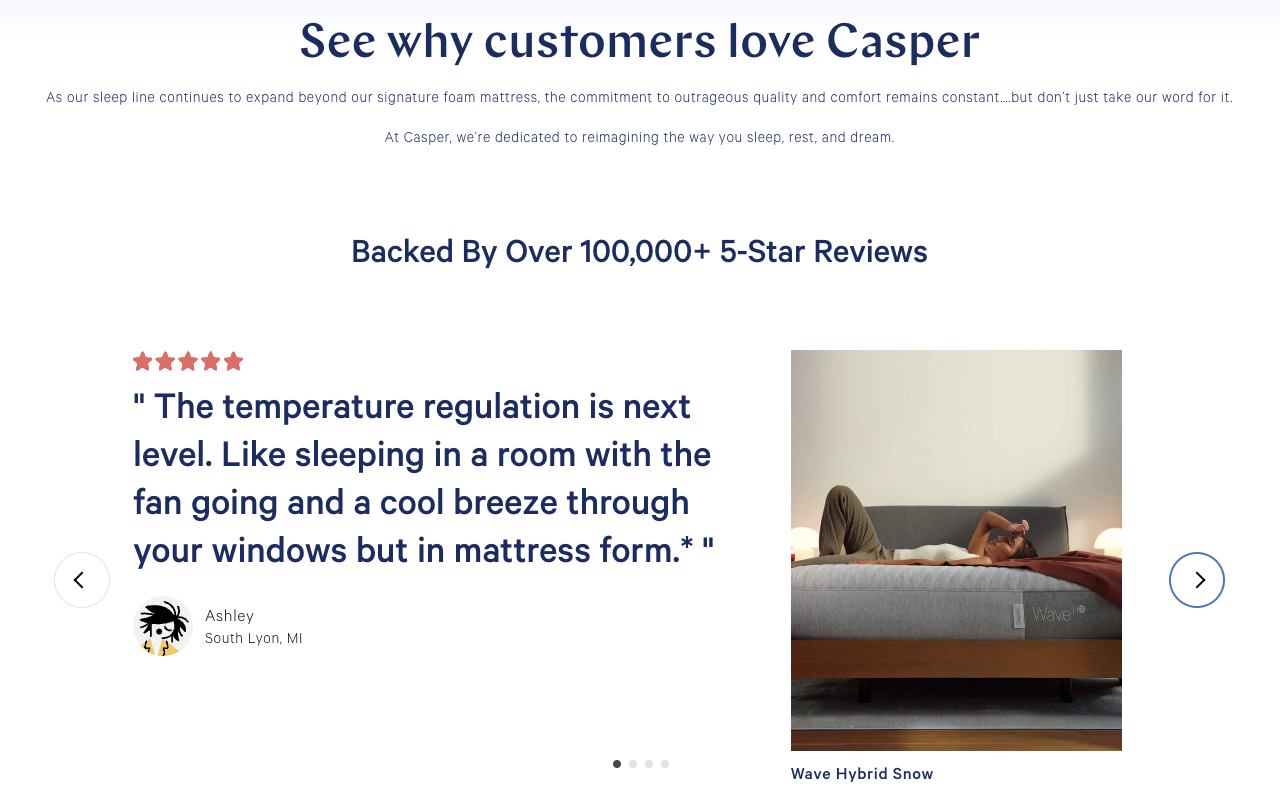
Your goal at the consideration stage is to engage with the buyer and make your product stand out from the rest. Here’s how you can go about it:
-
Where does your buyer go to find and compare solutions?
-
What information does your buyer need to compare solutions (e.g., pricing)?
-
How does the buyer weigh the pros and cons of solutions?
-
How does the buyer digest information the best?
-
What are the buyer’s deal-breakers?
Customer need: “I need a medium-firm mattress”
Your goal: Showcase why your medium-firm mattress is worth buying
Metrics to measure: Returning visitors; Webinar registrations
Stage 3: Conversion (BoFu)
At this stage, Emma is ready to buy but now the question becomes: Are you the right choice? Will you provide the ultimate solution that solves the buyer’s problem?
Your goal during the decision stage is to minimize the buyer’s hesitations. Here’s how you can go about it:
-
Will the buyer hesitate on price?
-
Are they concerned about extra shipping costs?
-
Are they confused that you’re the right solution?
-
Do buyers need to prepare to implement the solution?
-
Is your buyer more likely to make a decision if they can try the product first?
-
What questions does the buyer have about implementing your solution?
-
What are the most important criteria for your buyer’s decision-making process?
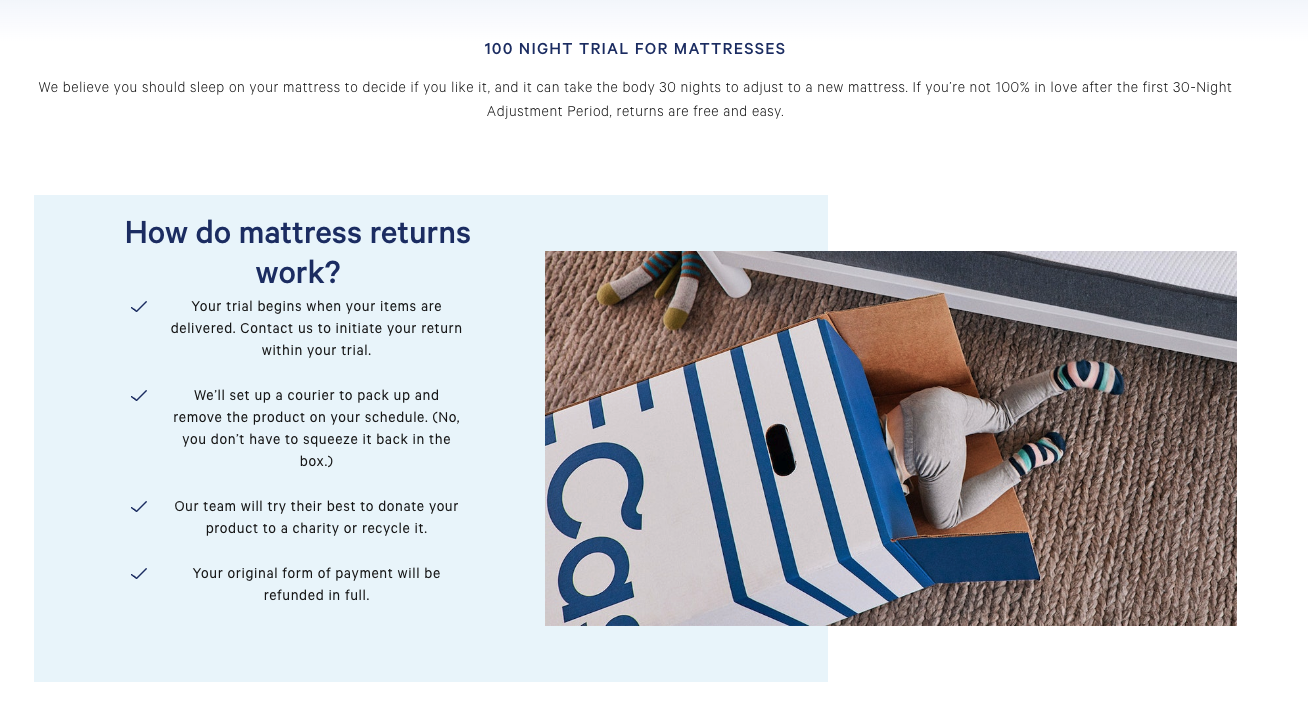
Customer needs: “I want to buy your medium-firm mattress.”
Your goal: Clear all doubts and lead him/her to check out
Metrics to measure: Customer acquisition cost; customer lifetime value, and conversion rate.
Importance of Mapping Content to Funnel Stage
Today's buyers are more informed than ever, and as content marketers, it’s your responsibility to provide relevant information at each step of the buyer’s journey. 84% of people expect brands to create content that provides solutions and creates experiences.
It takes a lot of careful planning and a clear understanding of the buying journey to show up with content that educates them and makes your product a no-brainer.
Therefore, educating your customers at each touch point they have with your brand is more important than ever to help them pick the right solution — aka your product.
The bottom line is that only value-added content can convert prospects like Emma into paying customers. But what exactly is this value-added content? Is every piece of content suitable for each phase of the buyer's journey?
The answer is No.
Since each stage represents a distinct point in the buyer's journey, it needs a unique type of content to move the prospect forward and convert them to leads, then to customers.
This brings us to the Content Marketing Funnel - a model of your buyer's journey and the types of content that support each stage of the funnel. The three phases of the content marketing funnel are:
-
Top of the funnel (ToFu): This category of content offers relevant information that addresses a customer’s need, question, or problem in the “Awareness” stage.
Content for this stage may include blogs, eBooks, infographics, etc.
-
Middle of the funnel (MoFu): MoFu is where a brand positions itself as the best provider of a product to suit the customer's needs.
In the "Consideration" step of the buyer's journey, MoFu content, such as podcasts and comparison tables, is proven to be highly effective.
-
Bottom of the funnel (BoFu): Such content is crafted to meet any sales objections that typically arise at the “Decision” stage - whether they’re related to pricing, shipping cost, etc.
For reassuring customers, testimonials, trials, and webinars are useful.
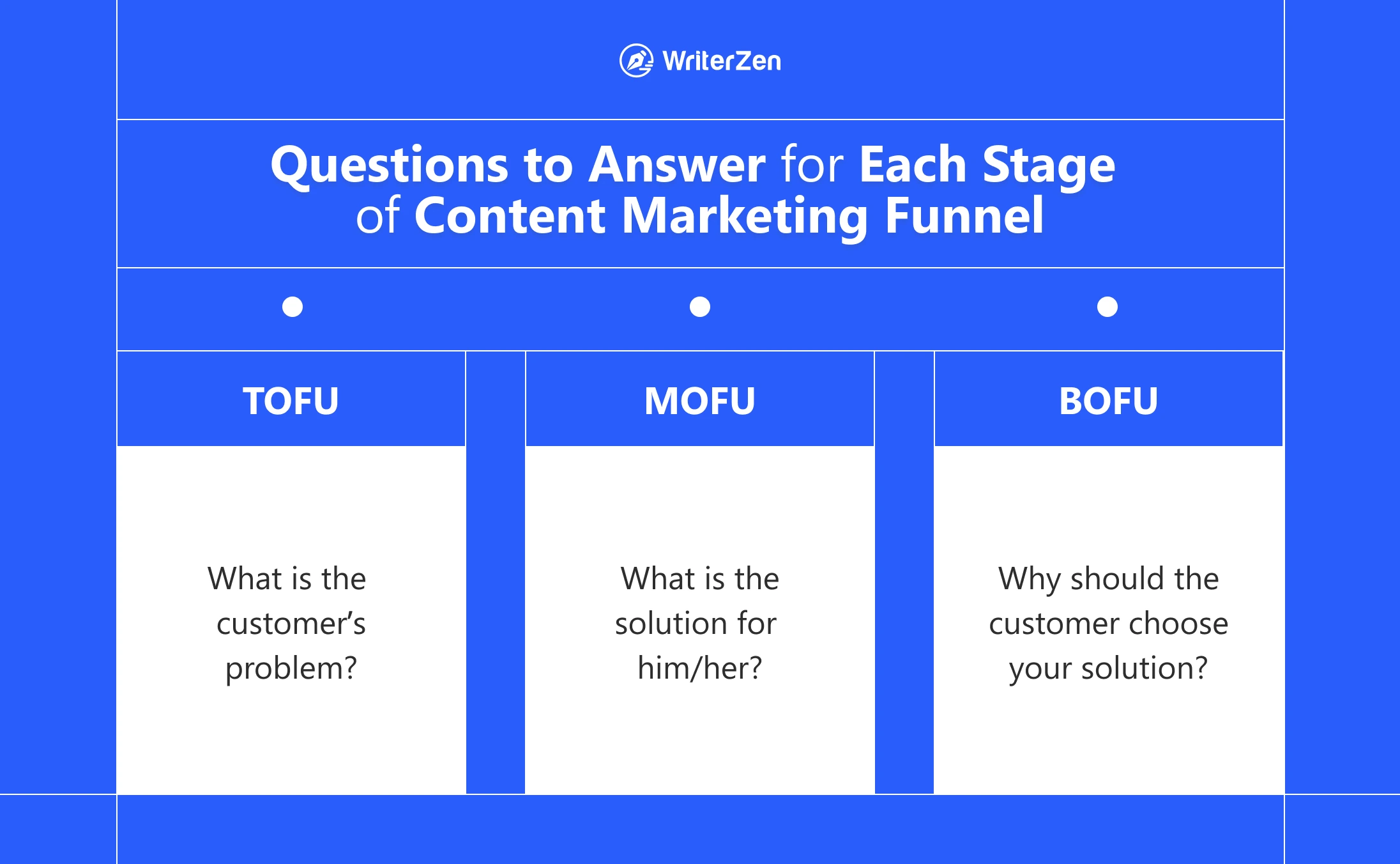
Three Essential Steps for Creating Content Across the Funnel
Step 1: Use Customer Research to Identify Which Content to Produce
What was the last ad you saw that not only resonated with you but also pinpointed the exact feeling you get when faced with a challenge? Ever thought how that brand dialed up anticipation around the solution that effortlessly connected with you?
The answer is customer research.
Understanding customers' buying behavior isn't an easy job to do. However, it's not difficult either if you harness customer interviews that give you granular details straight out of their mouth.
The content that converts always has customer data at the heart of content production. If you aim to convince and convert customers, treat content like the product. Your content should solve big problems for your customers just the way your product does.
Here are some great pragmatic ways to find the topics you should be prioritized:
-
Customer interviews
-
Testimonial videos
-
Software review websites (G2/Capterra)
-
Social media comments
-
Comments on your competitor’s/industry influencer’s social media posts
-
Product features purpose (what are they meant to alleviate/help people do)
-
Google Search Console query data
-
Questions/feedback that sales/success/support and the product teams receive
-
Newsletter responses
-
Read the content your dream clients/customers are creating
-
Jobs-to-be-Done framework
From checking out your website to completing a purchase, they can give you all the details of their experience and where they want to see more improvement.
Once you’ve determined what type of content your buyers need at each stage, you must make sure your sales reps are ready to run with every opportunity.
Step 2: Connect The Dots between Search Intent and Funnel Stage
It might happen that you’re sitting on stellar content that simply isn’t ranking for their target keywords. Ask why?
Oftentimes, the funnel stage and intent simply don’t match.
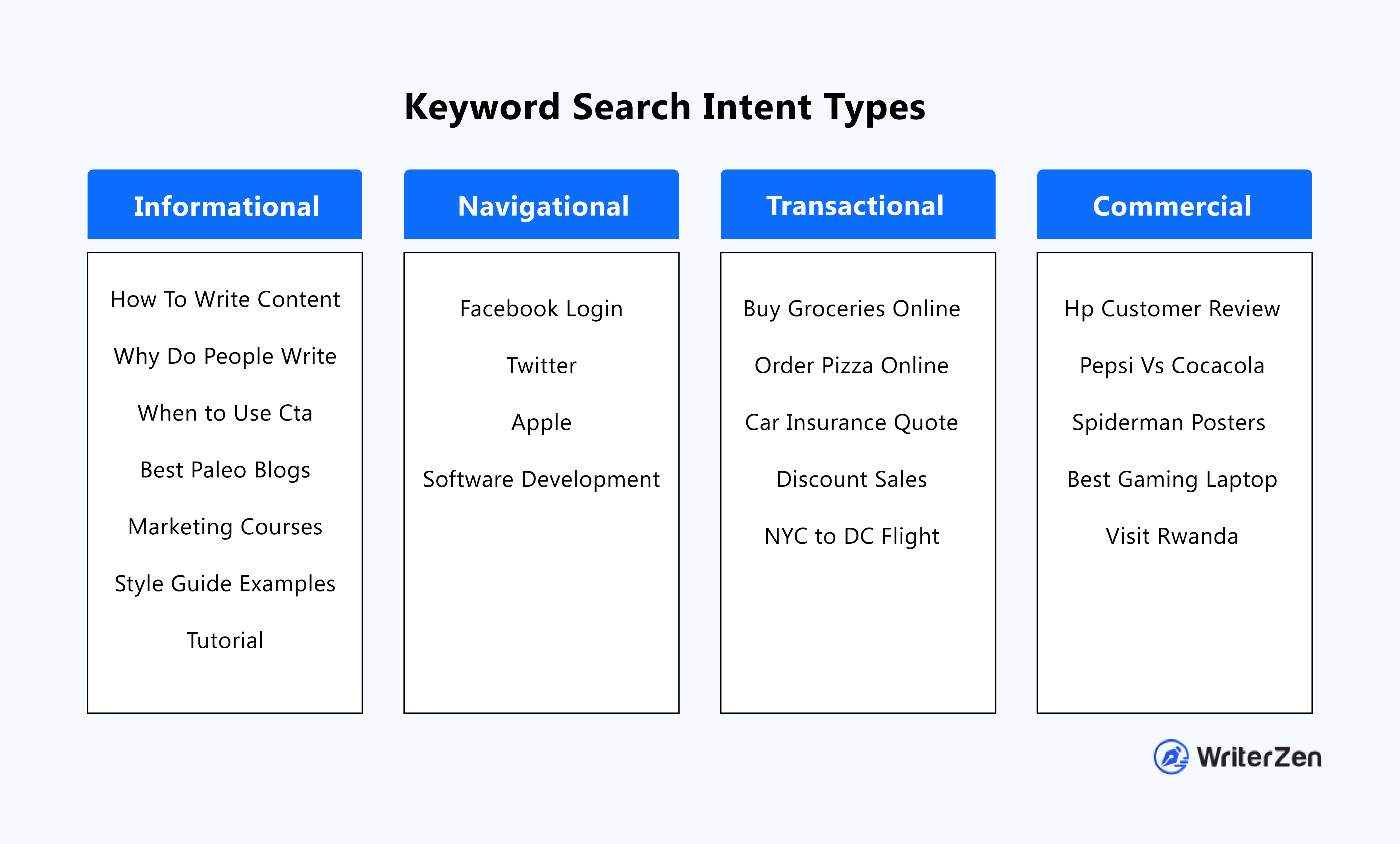
Let’s say, Emma wants to eat sushi on her weekend. However, it is unclear whether she wants to make the sushi herself or order one. This is where the concept of intent comes in - searching for sushi recipes has a different intent than searching for takeout sushi.
The four popular search intents are as follows:
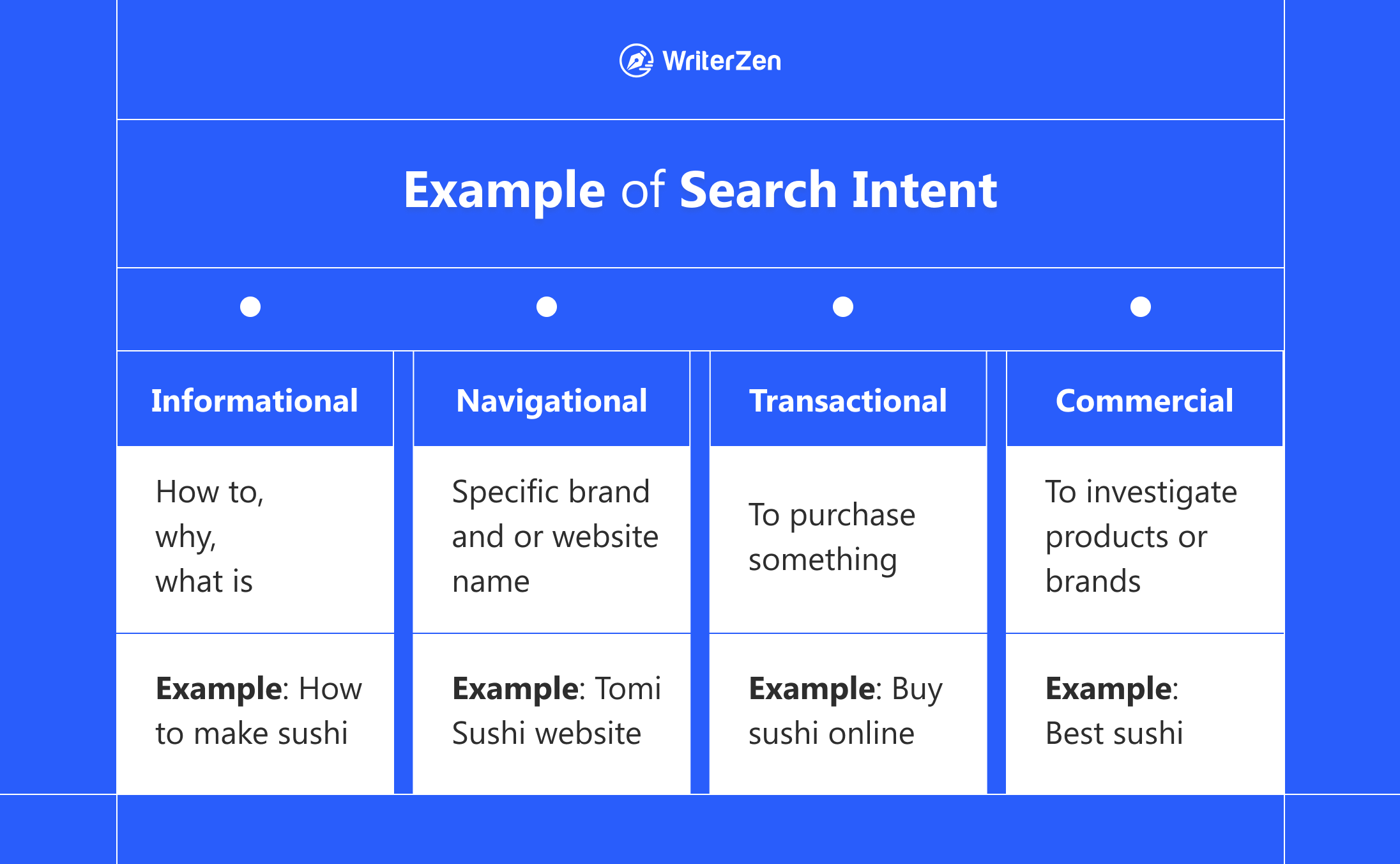
So, before generating content, you need to optimize your search intent. Here’s how you can go about it:
-
Match metadata to the intent - Update your title tag, H1, and H2s to reflect your specific keyword targeting.
-
Match your content to the intent - For informational intent, go for a step-by-step guide. To match commercial queries, display product comparison articles. For transactional intent, display product pages.
Now, let's look at how search intent changes at each stage of the funnel:
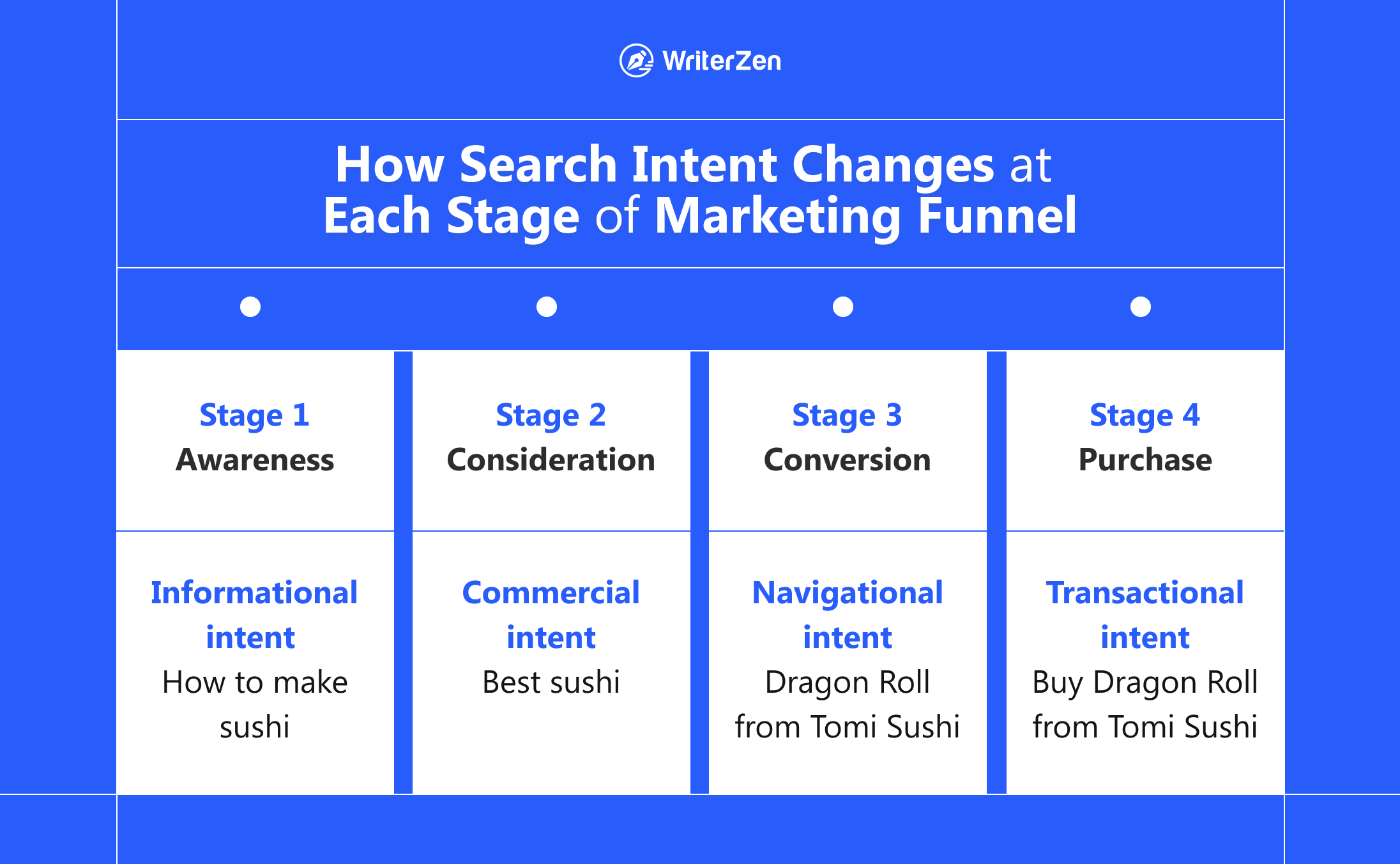
Step 3: Create Content from ToFu to BoFu
As reported by the Content Marketing Institute, 90 percent of marketers use content marketing to generate demand across all stages of the buyer's journey.
This means writing whatever you want isn’t helpful.
There’s a high chance that the topic you deem engaging may not be valuable to your audience. And in the end, you create fluffy content.
Simply put, your content is pointless without a solid SEO strategy.
Top-of-the-Funnel (ToFu) Content:
ToFu content is your foot in the door—it’s designed to help you introduce your brand to site visitors who could eventually become customers.
-
Target high-volume keywords with informational intent.
-
Instead of being product-specific, simply find long-tail variations that are relevant to your business and appealing to potential customers.
-
ToFu content includes blogs, eBooks, short videos, social media posts, influencer content, infographics, etc.
Let’s say you’ve built a Content Management tool. One example keyword to target could be how to be a content writer.
With a monthly volume of 6600, there’s a fair amount of search traffic to capture and it’s relevant to the functionality of the product without being specific to the product itself.
Take Dollar Shave - a male grooming brand - for example. The company has rightly created a blog to educate potential customers about razor bumps.
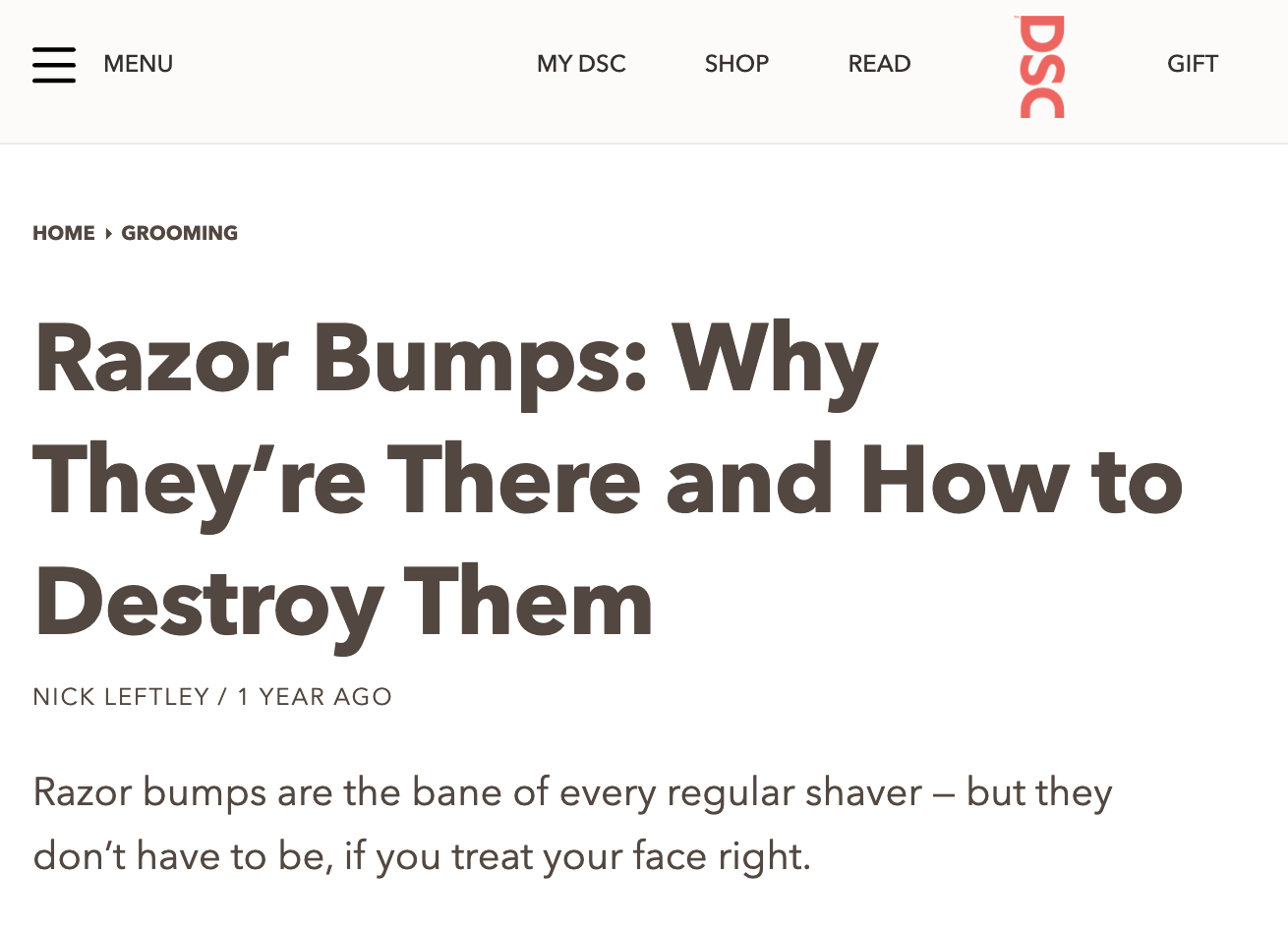
Middle-of-the-Funnel (MoFu) Content:
Potential customers have already been introduced to your brand via ToFu content, so it's time to persuade them that your company has the finest solution. This is done using MoFu content. It emphasizes the unique value your product or service offers.
-
Target keywords with commercial intent.
-
Focus on low-volume, competitive keywords that are more closely related to your product.
-
Examples include case studies, white papers, product comparisons, testimonials etc.
Through vendor comparison content, the mattress brand Casper tries to persuade buyers in the Consideration stage.
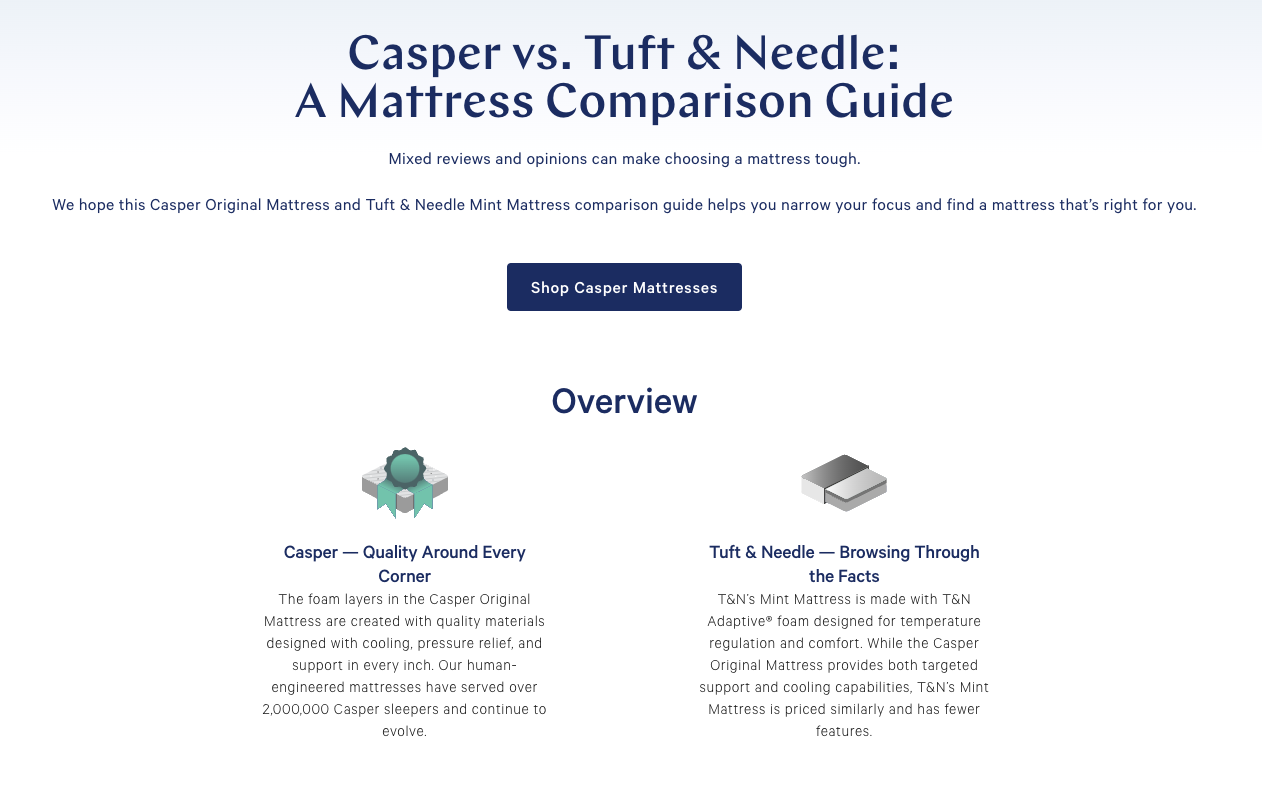
On the other hand, WriterZen has showcased multiple case studies as follows:
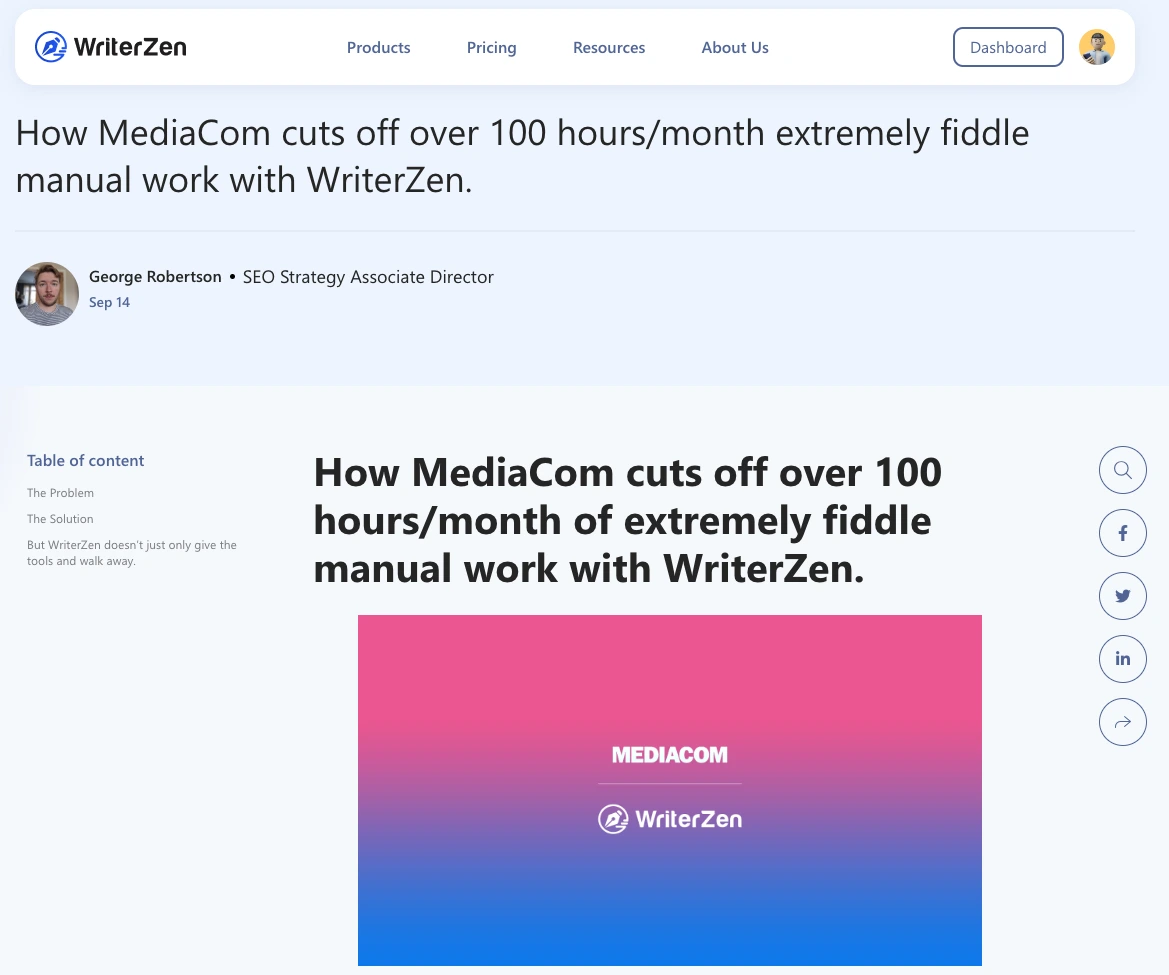
Bottom-of-the-Funnel (BoFu) Content:
Now that we've reached the BoFu stage, everything of the content should be laser-focused on conversion. Your audience is ready to make a decision on the product that’s best suited for their needs, and now’s your time to close the deal.
-
Use “buy” to start a string of three or four words that describe your product.
-
The keywords should have transactional intent.
-
Effective content at this stage includes pricing pages, product demo pages, customer stories, warranty, etc.
Remember, customers dislike being pushed. Therefore, it is beneficial to offer additional perks that aid in the purchase decision.
For instance, you may provide complimentary warranties (like the brand Casper) and a friendly customer service policy to get the ball in your court.
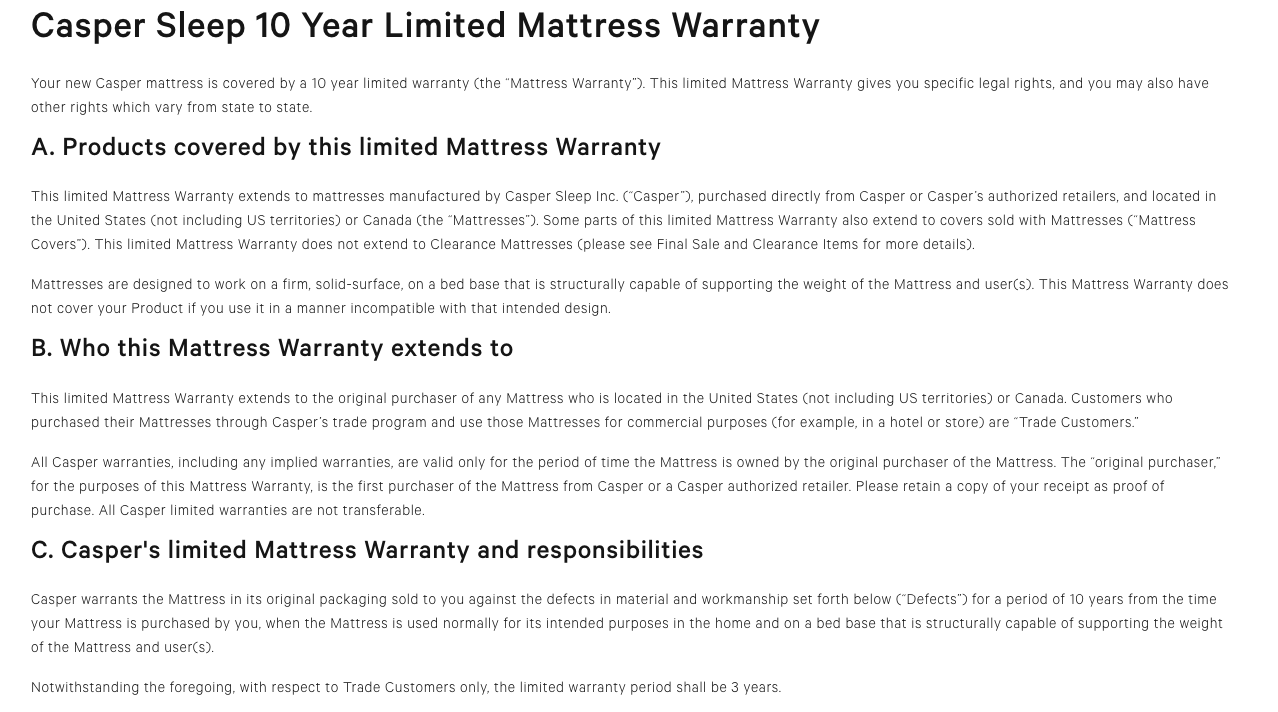
Ready to Create Content that Covers the Entire Funnel?
Now that you know what goes into a content marketing funnel and how it works, start thinking of all the ways your business can use content to reach your customers.
As you put everything together, each buyer’s journey will look different.
Someone could find your website through a blog post, sign up for your newsletter, and decide to buy from you after a free trial. Another person could find you through a video, look at one of your case studies, and decide to buy from you based on a hassle-free.
The possibilities are endless!


